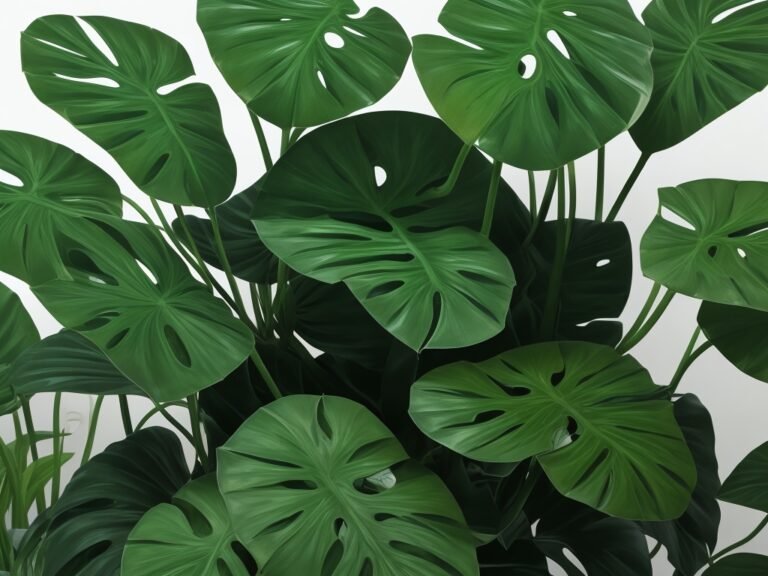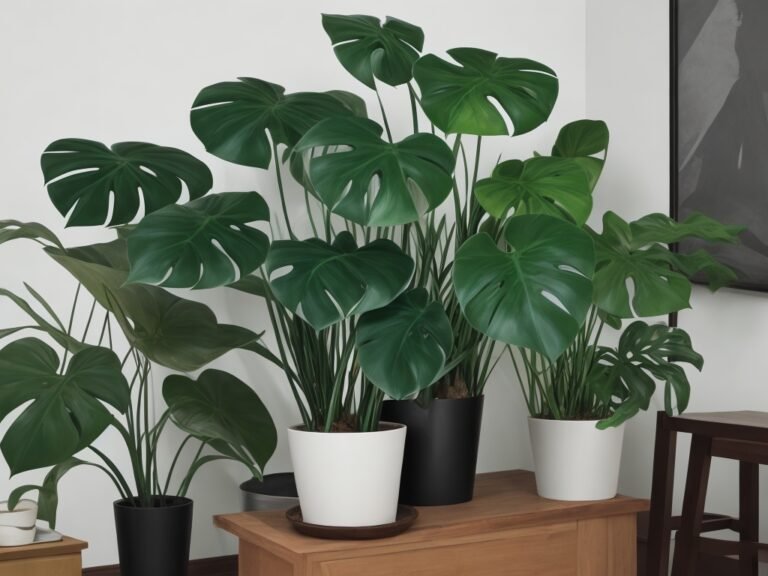How Big Of a Pot Does a Monstera Need – Expert Tips!
Key Takeaways:
- Monstera plants require a pot that is at least 10-12 inches in diameter.
- A larger pot allows the roots to spread and promotes healthier growth.
- Proper drainage is important to prevent waterlogging and root rot.
- Repotting may be necessary every 1-2 years to accommodate the plant’s growth.
Are you someone who loves plants?
If so, you might be familiar with the stunning Monstera plant.
These tropical beauties have become incredibly popular in recent years, adorning countless homes and offices with their large, vibrant leaves.
But have you ever wondered how big of a pot a Monstera actually needs?
Well, look no further! In this article, I’m going to share my expertise on understanding the growth and pot requirements of Monstera plants.
We’ll explore the growth habits and characteristics of Monstera, the importance of choosing the right pot size, and even cover signs that indicate your Monstera needs a bigger home.
So, whether you’re a Monstera newbie or a seasoned plant lover, keep reading to discover all you need to know about pot sizes for Monstera plants.
| Pot Size | Monsteras |
| 4-6 inches | Small baby Monstera plants |
| 6-8 inches | Young Monstera plants |
| 8-10 inches | Mature Monstera plants |
| 10-12 inches | Large and established Monstera plants |
Understanding the Growth and Pot Requirements of Monstera Plants
Understanding how Monstera plants grow and what pot size they need is essential for their health and development.
Growth Habits and Characteristics of Monstera Plants
Monstera plants are known for their large, glossy, and perforated leaves, which give them a unique and tropical appearance.
These plants have a vining growth habit, meaning they will naturally climb and trail if given the opportunity.
Monstera plants can grow to be quite large, with some reaching heights of up to 10 feet or more.
They are also known for their aerial roots, which they use to cling onto surfaces and absorb moisture and nutrients.
The leaves of a Monstera can change shape and develop holes as the plant matures, giving it a distinct and beautiful look.
Overall, Monstera plants are relatively easy to care for and can make a stunning addition to any indoor or outdoor space.
Why Choosing the Right Pot Size Matters
Choosing the right pot size for your Monstera plant is important because it directly affects its growth and overall health.
A pot that is too small can restrict root development and cause stunted growth, while a pot that is too large can lead to waterlogged soil.
The right pot size ensures proper drainage, allows for healthy root growth, and promotes optimal plant growth.

Factors to Consider When Choosing a Pot Size for Your Monstera
When choosing a pot size for your Monstera, there are several factors to consider.
The Importance of Proper Drainage
Proper drainage is crucial for the health of your Monstera plant. It prevents water from accumulating in the soil, which can lead to root rot and other issues.
Good drainage allows excess water to escape, ensuring the roots have enough oxygen and preventing waterlogged soil.
Considering the Plant’s Current Size
When considering the plant’s current size, it’s important to choose a pot that provides enough space for the roots to grow and expand comfortably. If the pot is too small, the roots may become overcrowded, stunting the plant’s growth.
On the other hand, if the pot is too large, the soil may retain too much moisture, leading to root rot.
It’s best to select a pot that allows for some room for growth but isn’t excessively large.
Future Growth Potential
Future Growth Potential is an important factor to consider when choosing a pot size for your Monstera plant.
Monstera plants are known for their vigorous growth and large, sprawling leaves.
They have the potential to grow quite large over time, so it’s crucial to choose a pot size that will accommodate their future growth.
Keep in mind that giving your Monstera plant ample room to grow will help promote healthy root development and overall plant growth.

Root Development and Healthy Growth
Root development is essential for the healthy growth of monstera plants.
Adequate root growth allows the plant to anchor itself and absorb nutrients and water from the soil.
Healthy roots result in lush foliage and overall plant vigor.
It’s important to choose the right pot size to promote root development and ensure that the plant has enough space to grow and expand its root system.
Additionally, providing proper drainage is crucial to prevent waterlogged roots, which can lead to root rot and hinder healthy growth.
Recommended Pot Sizes for Different Stages of Monstera Growth
Choosing the right pot size for your monstera depends on its growth stage. Here are the recommended pot sizes for young, medium-sized, and mature monstera plants.
Pot Sizes for Young Monstera Plants or Cuttings
For young Monstera plants or cuttings, it’s important to choose an appropriately sized pot.
A small pot, around 4-6 inches in diameter, is ideal as it provides a snug fit for the young roots.
This size allows for proper root development, while also preventing overwatering and stagnant moisture.
As the plant grows, you can gradually increase the pot size to accommodate its expanding root system.
Pot Sizes for Medium-sized Monstera Plants
Medium-sized Monstera plants typically require pot sizes that are slightly larger than their current root ball. A good rule of thumb is to choose a pot that has a diameter that is 2-4 inches wider than the current pot.
This will provide enough space for the roots to comfortably grow and expand.
Remember to always ensure proper drainage to prevent overwatering.

Pot Sizes for Mature Monstera Plants
Pot sizes for mature Monstera plants should range from 12 to 16 inches in diameter. This allows enough room for the roots to spread out and promotes healthy growth.
Ensure the pot has good drainage to prevent waterlogged soil.
Consider repotting every 2-3 years or when the plant shows signs of needing a bigger pot.
Signs That Your Monstera Needs a Bigger Pot
Is your Monstera showing stunted growth or yellowing leaves?
It may be a sign that it needs a bigger pot.
Stunted Growth or Yellowing Leaves
Stunted growth or yellowing leaves are common signs that your Monstera plant might need a bigger pot.
These issues can occur when the roots become overcrowded and unable to access enough nutrients or water.
Repotting into a larger pot will provide more space for root growth and help revive your plant.
Root Bound or Overcrowded Roots
Root bound or overcrowded roots refer to a situation where the roots of a plant have outgrown its pot, causing them to become tightly packed and tangled. This can hinder the plant’s growth and lead to various issues such as stunted growth, yellowing leaves, and difficulty absorbing water.
If you notice these signs, it’s time to repot your Monstera into a larger pot to give its roots more space to grow and thrive.
Difficulty Absorbing Water or Frequent Wilting
If your Monstera is having difficulty absorbing water or frequently wilting, it may be a sign that it needs a bigger pot. This can happen when the roots become overcrowded or the pot is too small to support the plant’s growth.
Repotting into a larger pot with proper drainage can help improve water absorption and prevent wilting.
Steps to Repotting Your Monstera Plant
To repot your Monstera plant, you’ll need to choose the right potting mix, prepare the new pot and plant, carefully transfer the Monstera, and follow post-repotting care tips.
Choosing the Right Potting Mix
Choosing the right potting mix for your Monstera plant is important for its overall health and growth.
A well-draining mix that retains some moisture is ideal.
Look for mixes that contain a combination of peat moss, perlite, and vermiculite.
It’s also a good idea to add some organic matter, such as compost or coconut coir, to improve water retention.
Avoid heavy or compacted soils, as they can lead to root rot.
Remember to repot your Monstera every 1-2 years to refresh the potting mix and ensure its continued vitality.
Preparing the New Pot and Plant
To prepare the new pot and plant for repotting your Monstera, make sure to:
- Clean the pot: Wash the new pot with warm water and mild soap to remove any dirt or residue.
- Add drainage material: Place a layer of small stones or broken pottery at the bottom of the pot for proper drainage.
- Add fresh potting mix: Fill the pot with a well-draining potting mix, leaving enough space for the plant’s root ball.
- Loosen the roots: Gently loosen the roots of your Monstera to encourage healthy growth and prevent them from circling.
- Place the plant in the new pot: Position the plant in the center of the pot, making sure it is at the same depth as before.
- Fill with soil: Fill in the gaps around the roots with fresh potting mix, pressing it down gently to secure the plant.
- Water thoroughly: After repotting, give your Monstera a good soak to ensure the soil is evenly moist.
Remember to place your repotted Monstera in a suitable location with adequate light and proper care!
Carefully Transferring the Monstera to the New Pot
To carefully transfer your Monstera to a new pot, start by gently loosening the soil around the edges of the current pot.
Carefully lift the plant out, supporting the base of the stem to avoid damage.
Place the Monstera into the new pot, making sure it sits at the same depth as before.
Fill in the gaps with fresh potting mix, making sure not to pack it too tightly.
Water the plant thoroughly after repotting and place it in a suitable location.
Post-Repotting Care Tips
After repotting your Monstera plant, it’s important to give it proper care to ensure its health and growth. Here are some post-repotting care tips:
- Watering: Keep the soil moist but not overly wet. Water your Monstera when the top inch of soil feels dry.
- Light: Place your Monstera in bright, indirect light. Avoid direct sunlight, as it can burn the leaves.
- Temperature and Humidity: Monstera plants prefer temperatures between 65-85°F (18-29°C and humidity levels of 50% or higher. Mist the leaves or use a humidifier to increase humidity if necessary.
- Fertilizing: Wait a few weeks after repotting before fertilizing your Monstera. Use a balanced, water-soluble fertilizer and follow the instructions on the packaging.
- Pruning: Remove any yellow or damaged leaves to promote healthy growth. You can also prune to shape or control the size of your Monstera.
Remember, each plant is unique, so observe your Monstera closely and make adjustments to its care routine as needed.
Frequently Asked Questions about Pot Sizes for Monstera Plants
Can I Use a Big Pot for a Small Monstera?
Yes, you can use a big pot for a small Monstera, but it’s not recommended. A large pot can actually hinder the plant’s growth and lead to overwatering.
It’s best to choose a pot that is slightly larger than the current root size to allow for healthy root development.
Can I Repot a Monstera that is Currently Blooming?
Yes, you can repot a Monstera that is currently blooming. However, be aware that repotting may cause some stress to the plant, so it’s best to wait until after the blooming period if possible.
When you do repot, be gentle with the roots and provide proper care to help the plant recover.
What If I Don’t Have a Pot with Drainage Holes?
If you don’t have a pot with drainage holes, you can still use it for your Monstera plant by creating a drainage layer at the bottom.
Place a few inches of small rocks, gravel, or perlite in the pot before adding the soil.
This layer will help prevent excess water from pooling at the bottom and causing root rot.
Just be sure not to overwater your plant and monitor the moisture levels regularly.
How Often Should I Repot My Monstera?
You should repot your Monstera plant every 1-2 years, or when you notice signs of it outgrowing its current pot. Some indicators include roots growing out of the drainage holes, stunted growth, and difficulty absorbing water.
Repotting helps ensure healthy root development and allows the plant to continue growing properly.
Final Verdict
Understanding the growth habits and pot requirements of monstera plants is crucial for their overall health and development. Choosing the right pot size based on factors like drainage, current size, future growth potential, and root development is essential.
Signs that your monstera needs a bigger pot include stunted growth, root-bound roots, and difficulty absorbing water.
When repotting your monstera, ensure you choose the right potting mix, prepare the new pot and plant, and provide post-repotting care. Frequently asked questions about pot sizes for monstera plants provide further insights for optimal plant care.
By following these guidelines, you can ensure your monstera thrives in its pot and continues to bring beauty and joy to your space.






